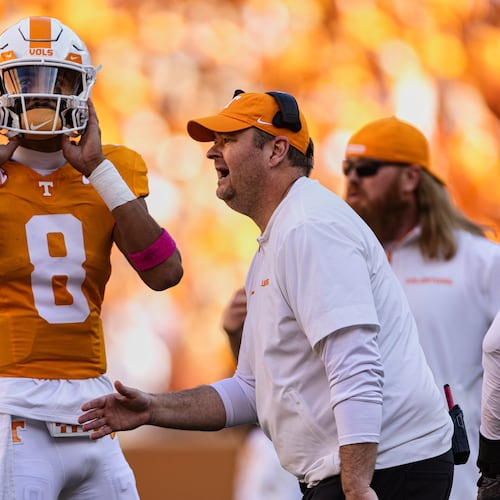ATHENS — A longtime, ardent supporter of Georgia football held up his cellphone. He’d just received a text message from a representative of the Classic City Collective, and he was sharing it with his buddies in the neighborhood cul-de-sac.
“We need everybody to step it up,” the message read. “We’re getting our (expletive) heads kicked in.”
That would be kicked in, as in on the recruiting trail.
How much the Bulldogs actually are struggling in recruiting is debatable. Georgia continues to be ranked among the top teams in the country in national recruiting rankings. But there is a perception and an internal belief that UGA is lagging behind when it comes to the newest competitive arena in college sports: name, image and likeness. The demand for money that goes to NIL could be a drain on traditional donations that don’t go directly to athletes but rather facility upgrades and the like.
NIL, as it is now commonly referred, has become the most intense battleground in college athletics. Never mind that NIL money was never intended to be used as an inducement for luring recruiting prospects to schools, that definitely is what is happening in the SEC and across the Power Five landscape in college football and basketball.
This summer, Alabama coach Nick Saban publicly called out Texas A&M coach Jimbo Fisher and the Aggies for utilizing a reported $30 million in NIL funds to distribute to recruits through a collective. After averaging a No. 9 ranking in recruiting over the previous five years, Texas A&M notably finished with the No. 1-ranked recruiting class in the 2022 cycle.
Georgia, which has averaged a 2.3 national ranking over that same span, finished fourth this year. Saban’s Alabama Crimson Tide were second.
Whether NIL guarantees had anything to do with those results is uncertain, but Georgia seems to believe it was a factor. Contributing to the NIL cause is definitely being encouraged by coach Kirby Smart. UGA, like it does in all athletic endeavors, intends to stay competitive in this arena as well, even at the expense of traditional fundraising.
“We see legitimate and permissible NIL opportunities as part of a larger whole,” Georgia athletic director Josh Brooks told The Atlanta Journal-Constitution on Wednesday. “While there may be a decrease in donations to athletics directly, we see donations to collectives who are trying to do things the right way, like the Classic City Collective, as contributing to our ultimate goal of winning championships.”
That was evident Monday night when Matt Hibbs was trotted out as the first speaker at the first Touchdown Club of Athens meeting of the football season. Hibbs, a former senior administrator in UGA athletics’ compliance office, is CEO of the still relatively new Classic City Collective (CCC).
According to its website, CCC is a “supporter-funded NIL facilitation platform” whose mission is “to position Georgia Athletics and athletes from all 21 sports for sustained success.” That’s particularly important for football, which serves as the revenue engine for itself and UGA’s other 20 sports.
Hibbs told Athens TD Club members that the CCC needed their financial help, according to several people in attendance. He pitched them on the three different ways they could assist. He said they could become members of CCC’s “Varsity Club” by contributing $21 a month. Or, for $42 a month, they would become members of the “Silver Britches Club.” Give them $210 every month and donors can join the elite “Heisman Club.” That one comes with some special perks.
In addition to a 15% discount on UGA merchandise, Heisman Club members get a free ticket to a CCC event, can participate in the collectives’ quarterly Zoom meetings and receive “two personal messages” from Georgia football players.
Of all this, Smart is acutely aware. In fact, he addressed it as he followed Hibbs as the TD Club’s featured speaker at that same meeting Monday night.
“We’re going to need a whole lot more than that,” he cracked of the CCC’s monthly contribution plan.
The TD Club audience laughed, but Smart wasn’t really joking. According to insiders speaking on the condition of anonymity, the Bulldogs are pushing to raise at least $10 million for their collective pool. Currently, that total stands at around $3 million.
Those numbers can’t be confirmed, however. These collectives operate as private businesses and are not subject to the open-record laws that apply to state institutions such as UGA.
Likewise, there’s no way of knowing exactly how much money players are making. It varies among individuals. In general, the biggest stars bank the most money.
According to the website On3.com, which attempts to keep an ongoing account of major NIL deals, Georgia quarterback Stetson Bennett’s current valuation is at $699,000. That ranks 27th in the nation among college football players, according to On3. Sophomore cornerback Kelee Ringo, made famous by his 79-yard, title-capping interception return for a touchdown in the national championship game, has banked $764,000 in NIL deals, per the website.
Otherwise, current Georgia players aren’t experiencing life-changing compensation when it comes to their ability to make money off their name.
“I’d say people just know who I am, I guess,” said sophomore receiver Adonai “A.D.” Mitchell, who made the touchdown catch that put the Bulldogs ahead for good against Alabama. “Like, they just know I made a catch in the game. You know, nothing really changed, to be honest. I’m still working, that’s all I can say.”
It’s the ability for a player such as Mitchell to capitalize on such a moment for which NIL was intended. It never was intended as an inducement for players to attend one institution over another. Technically, it remains an NCAA violation to promise money to a prospect to attend an institution. But, in fact, that’s exactly what is happening on the Power Five level.
The Matador Club, the primary collective group organized by Texas Tech, announced in July that it plans to sign 100 Red Raiders football players to one-year, $25,000 contracts. While the Bulldogs have offered no such guarantees for their players, Smart revealed at SEC Media Days last month that 95 of Georgia’s players have some sort of NIL deal. He also said their total compensation tops $3 million, which he said is tops in the SEC.
And as long as it is, Georgia intends to compete. That was Smart’s message when he spoke to a group of Magill Society donors after a recent scrimmage.
“They came around and told everybody that Kirby is going to speak in the courtyard of Reed Alley after the scrimmage,” said a person who was invited. “He said people come up to him all the time and ask what he thinks about NIL. He said, ‘It doesn’t matter what I think about NIL because, whether I like it or not, it’s not going away. It’s here’s to stay, it’s something we’ve got to deal with, and if we don’t deal with it, we’re going to get beat in recruiting.’ So, that’s the whole pitch.”
To no one’s surprise, NIL collective groups and third-party agents seeking to get a piece of the action are popping up everywhere. In some cases, players are getting directly involved.
Just this week, Bulldogs Nazir Stackhouse and Jaheim Singletary announced their association with a new group called “The Athens NIL Club.” Add their name to a list that includes CCC and “The Players’ Lounge,” a non-fungible token group by former Georgia players Keith Marshall and Aaron Murray.
It’s the proliferation of these new groups and a general lack of oversight that concerns college administrators.
“The potential downside is that students make decisions based on immediate financial considerations that have nothing to do with their name, image and likeness, rather than where they want to receive their education and develop as an athlete,” Brooks told the AJC. “They give up the long-term benefits in exchange for a short-term profit. The other downside is the involvement of unregulated third parties in the recruiting process who may not have the student’s best interest at heart. There are many good agents helping current student-athletes navigate this new world. But some, particularly in the recruiting process, are just involved to further their own self-interest.”
For now, at least, UGA and Smart are endorsing CCC. That’s where Smart is telling fans to go with their money if they want to help out the Bulldogs on the NIL battleground.
The frustrating part for Georgia football’s most loyal supporters is they’re being inundated with requests to financially assist. Fans already have to donate to the Bill Hartman Fund just for the right to buy season tickets for football. They’re incentivized with increased ticket priority (i.e.: better seats) to donate to the Magill Society, which uses the funds to finance facility projects.
In June, the UGA Athletic Association launched a $300 million “Commit to the G” fundraising campaign. That’s in part to help defray the cost of a just-approved Sanford Stadium improvement project that is scheduled to begin in 2023 and is projected to cost $68.5 million. Georgia also just started construction on a $26 million indoor tennis facility. That’s assuming that the final figures won’t go up because of the skyrocketing labor and materials costs.
“It’s crazy,” one prominent UGA donor said. “There’s not that much money out there. Plus, the stock market is tanking, and inflation is rampant. Yet, here we go again.”
Indeed, the United States is in the throes of inflation. In July, consumer prices rose 9.1% over the previous year, according to a government report. That’s the biggest yearly increase since 1981 and up from an 8.6% jump in May, according to PBS.org.
Amid that financial chaos, Georgia athletics wants supporters not only to keep sending them checks but send some the collectives’ way as well.
“As (a) free-enterprise guy who has made living in a capitalist society on my own wits, so to speak, I 100% support a player who signs with us and he’s in our program and he has done well and some company out there thinks he can help them sell chicken or cars or credit-union accounts or whatever it is,” the UGA supporter said. “I’ve got no problem with that whatsoever. … But now the toothpaste is out of the tube with NIL, and I don’t know how they’re going to get it back in. Obviously, they need to try, whether it’s through the federal or state governments or whether it’s through the toothless NCAA. But it’s crazy out there right now. It’s the Wild West.
“College football and college athletics feels like a runaway train right now, and runaway trains eventually wreck. That’s what it’s felt like for a while.”
About the Author
Keep Reading
The Latest
Featured


